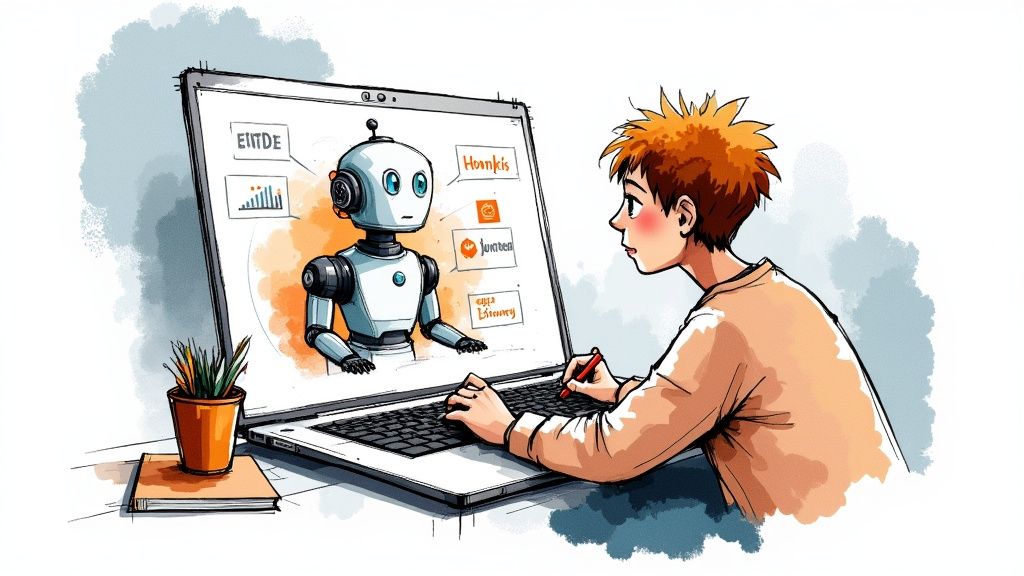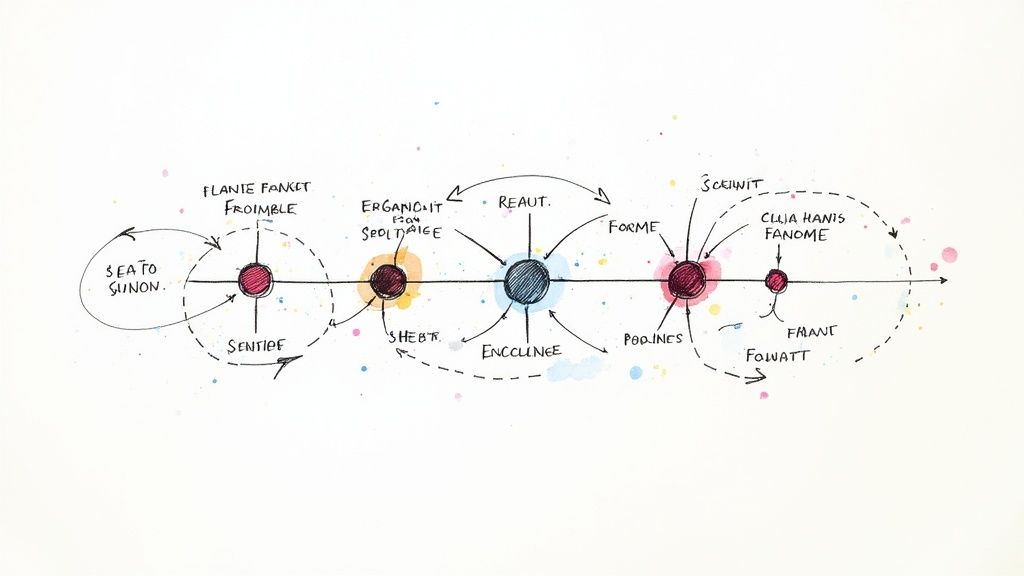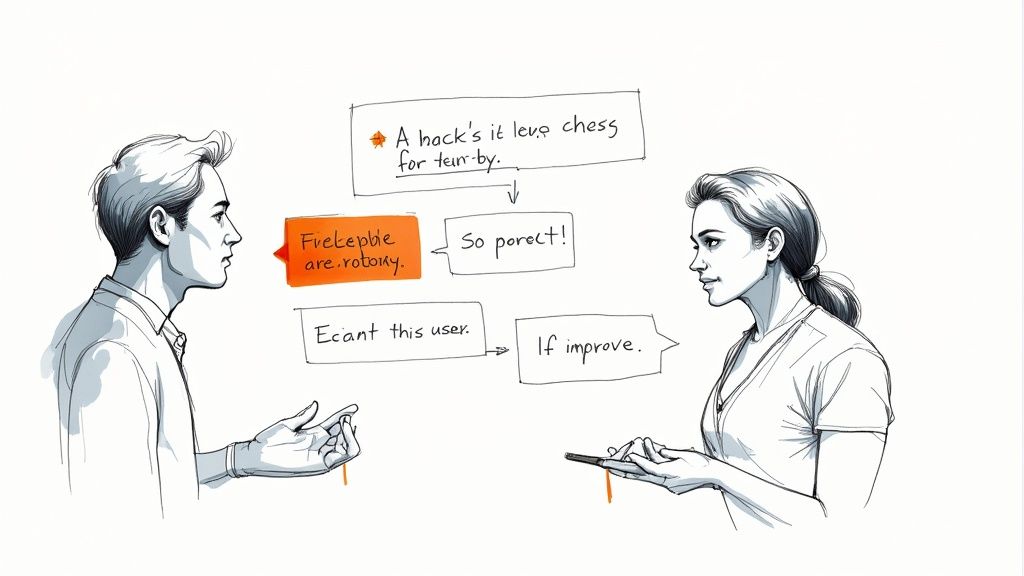How to Create an AI Chatbot: A Step-by-Step Guide for Success
Understanding AI Chatbots: From Simple Scripts to Intelligent Assistants

AI chatbots have come a long way since their early days. What started as basic programs has grown into smart, conversational assistants that can engage in natural dialogue. Understanding this progression helps explain how modern AI chatbots work and what makes them effective tools for businesses and users alike.
Rule-Based Chatbots: The Foundation
The first chatbots operated on simple if-then rules, much like a flowchart or decision tree. These rule-based chatbots could only respond to exact phrases and commands. For example, if a customer typed "shipping costs," they'd get a preset answer about shipping rates. But slight variations like "delivery fee" might confuse them. While useful for basic tasks, these early chatbots struggled with natural conversation and couldn't adapt to different ways of asking the same question.
AI-Powered Chatbots: A Leap Forward
The rise of Artificial Intelligence (AI) and Natural Language Processing (NLP) changed everything. Modern chatbots can grasp the meaning behind messages, even when worded differently. They use machine learning to study countless conversations and pick up on language patterns. This means they can handle casual chats and understand context better than their predecessors. The story of chatbots goes back to the 1960s - the first one, called ELIZA, was built at MIT in 1966. Learn more about the history of chatbots here.
The Power of Modern AI Chatbots
Today's AI chatbots do much more than answer questions. Using deep learning and advanced algorithms, they create personal experiences for each user. They can recall past chats, learn preferences, and even predict what someone might need next. Many can now handle complex tasks like scheduling appointments or processing orders.
For businesses, this means better customer service with a personal touch. A chatbot on an online store, for instance, doesn't just answer product questions - it can suggest items based on what customers have viewed or bought before. This kind of personalized and proactive support shows how far chatbots have evolved from their simple beginnings. And with ongoing improvements in AI technology, they keep getting better at helping both companies and customers.
Building the Business Case for Conversational AI

AI chatbots deliver real, measurable benefits that make them a smart investment for most businesses. When implemented thoughtfully, these tools directly improve operational efficiency, boost revenue, and help build stronger customer relationships. Let's explore the specific ways chatbots can benefit your business.
Understanding the ROI of Chatbots
The business case for chatbots starts with clear Return on Investment (ROI). Most notably, AI chatbots can handle hundreds of customer conversations at once, allowing companies to maintain high service levels with smaller support teams. This reduction in staffing needs creates significant cost savings. The sales impact is equally impressive - chatbots guide customers through purchases with personalized recommendations, helping turn browsers into buyers.
Improving Customer Satisfaction with 24/7 Availability
Customer satisfaction soars when support is available around the clock. AI chatbots provide 24/7 availability, answering questions instantly at any hour. Quick response times and efficient issue resolution lead to happier customers who are more likely to return. As an added benefit, each chat interaction generates valuable data about customer preferences and pain points. This information helps companies fine-tune their products and services to better serve their customers' needs.
Industry Applications and Success Stories
AI chatbots are already proving their worth across many industries. Online retailers use them to create personalized shopping experiences. Medical practices streamline appointment scheduling and provide basic health information. Banks offer account support and transaction assistance. The chatbot market reached USD 525 million in 2021 and is growing at 25.7% annually. By 2021, over half of companies made chatbots a higher priority than mobile apps. See more stats here: Chatbot Industry Statistics and Trends. These real-world examples show how chatbots drive results in different business settings.
Building Your Business Case: Key Considerations
When making the case for chatbots, focus on specific, measurable benefits. Calculate expected savings in support costs, potential revenue increases, and projected improvements in customer satisfaction scores. Point out how platforms like Sitebot make it simple to create and manage an effective chatbot without major technical hurdles. With clear data and examples backing up each point, you can make a compelling argument for adding AI chatbots to your business toolkit.
Crafting Your Chatbot Strategy for Maximum Impact
Building an effective AI chatbot requires careful planning and a clear strategic approach. A well-designed chatbot needs to integrate smoothly with your existing operations while delivering real value to both your business and customers. Let's explore the key elements needed to develop a chatbot strategy that gets results.
Defining Clear Objectives: What Do You Want to Achieve?
Start by setting specific goals for your chatbot project. Think about what success looks like - maybe it's reducing support costs by 30% or boosting sales conversions by 25%. Your objectives will shape every aspect of development, from feature selection to implementation. For example, if you want to improve customer satisfaction, focus on quick and accurate responses to common questions. If sales growth is the priority, emphasize product recommendations and personalized offers.
Mapping the User Journey: Understanding Your Audience
Take time to analyze how customers interact with your business. Look for common questions, pain points, and moments where they need help most. This information helps you design a chatbot that steps in at exactly the right time with exactly the right assistance. When your chatbot anticipates and addresses customer needs proactively, you'll see better engagement and higher satisfaction rates.
Identifying Use Cases: Finding the Right Fit
Some tasks are perfect for chatbots, while others need a human touch. Focus on:
- Answering basic questions
- Providing product information
- Processing simple transactions
- Collecting initial customer data
These routine tasks are ideal for automation, letting your team focus on complex issues that require personal attention.
Setting Meaningful Success Metrics: Measuring What Matters
Choose specific metrics that connect directly to your goals. For customer service chatbots, track:
- Average response time
- First-contact resolution rate
- Customer satisfaction scores
- Number of successful handoffs to human agents
For sales-focused bots, monitor conversion rates and average order values. Regular measurement helps you spot areas for improvement and proves the chatbot's value.
Creating a Development Roadmap: Planning for Success
Break down your chatbot project into clear phases with realistic deadlines. Consider technical requirements, training needs, and potential challenges at each stage. Tools like Sitebot make implementation easier with their three-step process: content ingestion, customization, and deployment. This structured approach helps keep your project on track while making sure the final product meets your business needs.
Remember that success comes from matching the right strategy with the right tools. A thoughtful plan combined with capable technology creates a chatbot that truly helps your business grow.
Choosing the Right Technology Stack for Your Needs

Building an AI chatbot starts with picking the right mix of tools and technologies. The choices you make here directly affect how quickly you can build your chatbot, what it will cost, and what it can do. Let's explore the key factors to consider and popular options available.
Key Considerations When Choosing Your Stack
Before diving into specific technologies, it's important to think through what your chatbot needs to do. Here are the main factors that will guide your choice:
- Chatbot complexity: Simple FAQ bots can work well with basic platforms. If you need features like personalized suggestions or connections to other tools, you'll want more advanced AI capabilities.
- Room for growth: Think about your future needs. Pick a platform that can handle more users and new features without requiring you to start over from scratch.
- Working with your tools: Your chatbot may need to connect with your customer database, online store, or other business software. Make sure the platform you choose can easily share data with these systems.
- Cost factors: Consider the full picture - platform fees, development work, and ongoing updates. Look for the sweet spot between features and price that fits your budget.
Comparing Popular Chatbot Development Platforms
Here's a simple breakdown of some leading platforms to help you compare:
| Feature | Sitebot | Dialogflow | Amazon Lex |
|---|---|---|---|
| Ease of Use | High | Medium | Medium |
| AI Capabilities | Advanced (GPT-4) | Medium | Medium |
| Integrations | Website, Slack, Zendesk | Google Services, Various APIs | AWS Services |
| Pricing | Varies | Pay-as-you-go | Pay-as-you-go |
| Ideal For | Businesses of all sizes | Developers, Enterprises | Enterprises with AWS infrastructure |
For example, Sitebot makes it easy with just three steps: add your content, customize settings, and launch. This means you can get your chatbot up and running quickly, even without coding experience.
Selecting the Right AI Model
The AI model powers your chatbot's ability to understand and respond to users. Here are your main options:
- GPT-4: Best for natural conversations and handling complex topics. It can understand context well and give detailed, helpful responses.
- Other Large Language Models (LLMs): Some models specialize in specific areas or languages. These might work better for certain uses.
- Custom Models: For very specific needs, you could build your own model with your data. This takes more time and resources but gives you full control.
When choosing your technology stack, focus on what your business actually needs. Think about your goals, budget, and long-term plans. Making smart choices now will help you build a chatbot that truly helps your business grow.
Mastering Conversational Design for Engagement
Building an AI chatbot requires careful planning around user interactions. At its core is conversational design - the skill of creating natural, engaging dialogues that keep users coming back. Good design ensures your chatbot not only works properly but provides an experience users genuinely enjoy.
Understanding the Psychology of Conversation
People connect best with conversations that feel genuine and helpful. When designing your chatbot's responses, put yourself in the user's shoes. Consider how you'd want someone to speak to you in that situation. Small changes make a big difference - instead of "Account balance: $50", try "Your current balance is $50. What else can I help you with today?"
Developing Your Chatbot's Personality
Your chatbot needs a consistent personality that matches your brand and audience. A financial services chatbot might use clear, professional language, while a retail chatbot could be more casual and friendly. Pick a style - whether professional, warm, or witty - and stick with it throughout all interactions.
Maintaining Contextual Awareness
The best chatbots remember previous exchanges to make conversations flow naturally. This contextual awareness helps avoid asking users to repeat themselves. For example, if someone asks about flights to Paris, the chatbot should reference that city when suggesting hotels or activities later. This makes interactions feel more personal and efficient.
Handling Complex Interactions with Grace
Not every chat goes smoothly. Your chatbot should handle interruptions and topic changes gracefully. Clear options and helpful fallback responses can guide confused users back on track. Just as importantly, know when to connect users with human support for complex issues. Think of your chatbot as a skilled customer service representative who knows their limits.
Testing and Iteration: The Key to Improvement
Making a great chatbot takes time and testing. Regular feedback from real users helps refine the experience. Tools like Sitebot show you how people interact with your chatbot, highlighting areas to improve. Review transcripts, adjust responses, and keep enhancing the dialogue. The best chatbots evolve based on how people actually use them, not just how we think they might.
Launching and Optimizing Your Chatbot for Success

Getting your chatbot up and running is just the beginning. The real work lies in properly launching it and continuously improving its performance over time. Success requires careful attention to testing, user feedback, and data-backed improvements.
Pre-Launch Testing: Ensuring a Smooth Start
Before going live, thorough testing helps catch issues early. Think beyond just technical checks - you need to see how your chatbot handles realistic conversations and edge cases.
Key testing areas include:
- Basic Functionality: Check that core features work properly, including accurate answers, request handling, and system integrations
- User Experience: Have real people test conversations to ensure they flow naturally and help users accomplish their goals
- Performance Under Load: Verify that your chatbot maintains speed and reliability even during high-traffic periods
Gathering and Using Customer Input
Once live, make it easy for users to share their experiences. Their direct feedback provides insights you can't get any other way.
Consider these feedback channels:
- Quick Rating Systems: Add simple ways for users to rate interactions or flag issues
- Chat Reviews: Regularly analyze conversation logs to spot common problems or gaps
- Ongoing Updates: Use what you learn to refine responses and conversation paths
Post-Launch Optimization: Tracking What Matters
The launch marks the start of continuous improvement. Focus on metrics that show real business impact:
- Key Success Metrics: Track measurements tied to your goals - satisfaction scores, successful resolutions, response times
- Clear Reporting: Use tools that make it easy to spot trends and share results with stakeholders
- Response Testing: Try different conversation approaches to find what works best with your users
Keeping Your Chatbot Running Smoothly
Regular maintenance keeps your chatbot helpful and reliable:
- Fresh Content: Update information regularly to keep responses current and accurate
- System Health: Check often for technical problems or slow response times
- Security First: Stay on top of security updates to protect your system and user data
Building an effective chatbot takes time and attention. With proper testing, user feedback, and ongoing optimization, your chatbot can become a valuable part of your customer experience. Ready to build a chatbot that makes a real difference? Start creating your AI chatbot with Sitebot today!


